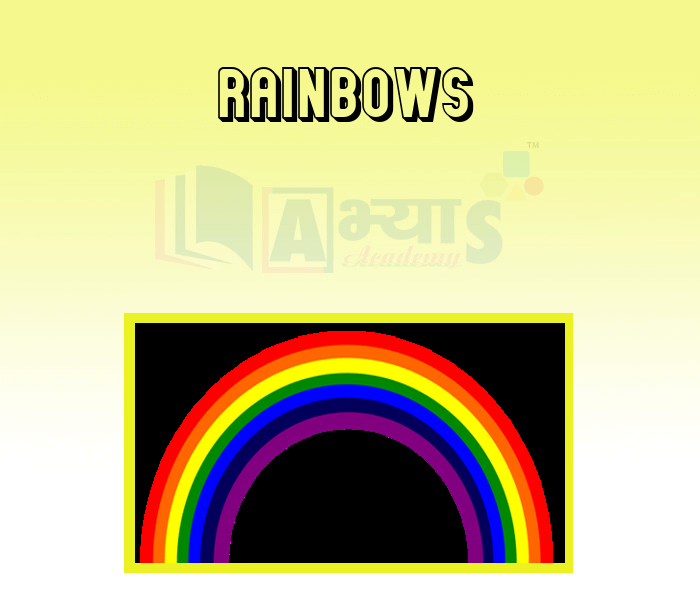Rainbows










Rainbows
Rainbows:
A rainbow is perhaps the most beautiful optical phenomenon. It appears as a seven-coloured arc in the sky when there are raindrops in the air. It is visible when the sun is low in the sky (early mornings and late afternoons). To see the rainbow, you have to stand with the sun behind your back.
From where does a rainbow get its colours? The colours come from the dispersion of white light by raindrops suspended in the air. Sunlight entering a drop gets refracted and is split into its component colours. The lights of the component colours travel through the drop and fall on its It other side. A part of these lights get reflected, and a part goes out. (This is not total internal reflection.) The reflected lights again fall on the surface of the drop and get refracted on the way out. The two refractions bend the lights through a large angle, keeping them separate. The lights of different colours emerging from the raindrops create a rainbow, with creates a rainbow red at the top and violet at the bottom.
You can see the rainbow effect at fountains, water sprinklers, waterfalls, and so on. In all these cases, light is dispersed by the droplets of water in the spray. To see the effect, stand with the sun behind you when it is low in the sky.
Which phenomenon does not play role in the formation of rainbow? | |||
| Right Option : D | |||
| View Explanation | |||
Rainbow is caused due to - | |||
| Right Option : B | |||
| View Explanation |
We can see a rainbow the sun should be positioned | |||
| Right Option : B | |||
| View Explanation | |||
Students / Parents Reviews [10]
My experience was very good with Abhyas academy. I am studying here from 6th class and I am satisfied by its results in my life. I improved a lot here ahead of school syllabus.

Ayan Ghosh
8thOne of the best institutes to develope a child interest in studies.Provides SST and English knowledge also unlike other institutes. Teachers are co operative and friendly online tests andPPT develope practical knowledge also.

Aman Kumar Shrivastava
10thAbout Abhyas metholodology the teachers are very nice and hardworking toward students.The Centre Head Mrs Anu Sethi is also a brilliant teacher.Abhyas has taught me how to overcome problems and has always taken my doubts and suppoeted me.

Shreya Shrivastava
8thIt has a great methodology. Students here can get analysis to their test quickly.We can learn easily through PPTs and the testing methods are good. We know that where we have to practice

Barkha Arora
10thAbhyas Methodology is very good. It is based on according to student and each child manages accordingly to its properly. Methodology has improved the abilities of students to shine them in future.

Manish Kumar
10thMy experience with Abhyas academy is very good. I did not think that my every subject coming here will be so strong. The main thing is that the online tests had made me learn here more things.

Hiya Gupta
8thA marvelous experience with Abhyas. I am glad to share that my ward has achieved more than enough at the Ambala ABHYAS centre. Years have passed on and more and more he has gained. May the centre flourish and develop day by day by the grace of God.

Archit Segal
7thMy experience with Abhyas is very good. I have learnt many things here like vedic maths and reasoning also. Teachers here first take our doubts and then there are assignments to verify our weak points.

Shivam Rana
7thBeing a parent, I saw my daughter improvement in her studies by seeing a good result in all day to day compititive exam TMO, NSO, IEO etc and as well as studies. I have got a fruitful result from my daughter.

Prisha Gupta
8thIt was good as the experience because as we had come here we had been improved in a such envirnment created here.Extra is taught which is beneficial for future.
